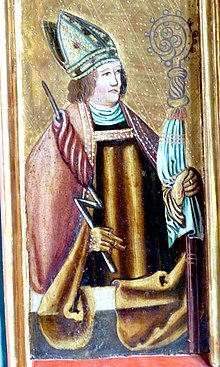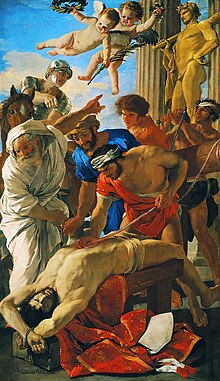| Saint Elmo of Formia | |
|---|---|
 St. Elmo by the Master of Meßkirch, c. 1530 St. Elmo by the Master of Meßkirch, c. 1530 | |
| Born | 3rd century |
| Died | c. 303 Illyricum (present-day Croatia) |
| Venerated in | Eastern Orthodox Church Roman Catholic Church |
| Feast | 2 June |
| Attributes | represented with his entrails wound on a windlass or as a vested bishop holding a winch or windlass |
| Patronage | sailors, Gaeta, Santeramo in Colle, Formia, colic in children, intestinal ailments and diseases, cramps and the pain of women in labor, cattle pest, Fort St. Elmo (Malta) |
Erasmus of Formia, also known as Saint Elmo (died c. 303), was a Christian saint and martyr. He is venerated as the patron saint of sailors and abdominal pain. Erasmus or Elmo is also one of the Fourteen Holy Helpers, saintly figures of Christian religion who are venerated especially as intercessors.
Documentation of his life
The Acts of Saint Elmo were partly compiled from legends that confuse him with a Syrian bishop Erasmus of Antioch. Jacobus de Voragine in the Golden Legend credited him as a bishop at Formia over all the Italian Campania, as a hermit on Mount Lebanon, and a martyr in the Diocletianic Persecution. There appears to be no historical basis for his passion.
Account of life and martyrdom
Erasmus was Bishop of Formia, Italy. During the persecution against Christians under the emperors Diocletian (284–305) and Maximian Hercules (286–305), he left his diocese and went to Mount Libanus, where he hid for seven years. However, an angel is said to have appeared to him, and counseled him to return to his city.
On the way, he encountered some soldiers who questioned him. Erasmus admitted that he was a Christian and they brought him to trial at Antioch before the emperor Diocletian. After suffering terrible tortures, he was bound with chains and thrown into prison, but an angel appeared and helped him escape.
He passed through Lycia, where he raised up the son of an illustrious citizen. This resulted in a number of baptisms, which drew the attention of the Western Roman Emperor Maximian who, according to Voragine, was "much worse than was Diocletian." Maximian ordered his arrest and Erasmus continued to confess his faith. Angered, Maximian had Erasmus enclosed in a barrel full of protruding spikes and rolled down a hill. His survival is claimed to be the result of the intervention of an angel.

A number of unreliable legends fill Erasmus’ story. Though he was thrown into prison with the intention of letting him die of starvation, Erasmus managed to escape. He was recaptured and tortured in the Roman province of Illyricum, after preaching and converting numerous pagans to Christianity. According to the traditional account, he was disemboweled; his abdomen slit open and his intestines wound around a windlass. This version may have developed from interpreting an icon that showed him with a windlass, signifying his patronage of sailors.
Veneration and patronage

Erasmus may have become the patron saint of sailors because he is said to have continued preaching even after a thunderbolt struck the ground beside him. This prompted sailors, who were in danger from sudden storms and lightning, to claim his prayers. The electrical discharges at the mastheads of ships were read as a sign of his protection and came to be called "Saint Elmo's Fire".
Pope Gregory the Great recorded in the 6th century that the relics of Erasmus were preserved in the cathedral of Formia. When the old Formiae was razed by the Saracens in 842, the cult of Erasmus was moved to Gaeta. He is currently the patron of Gaeta, Santeramo in Colle and Formia.
There is an altar to Erasmus in the north transept of St. Peter's Basilica. A copy of Nicolas Poussin's Martyrdom of St Erasmus serves as the altarpiece.
The skull of St. Erasmus, venerated as a relic, is purported to be in St. Peter's Church in Munich, Germany. Some other parts of his bones are in various parts of Europe.
Besides his patronage of mariners, Erasmus is invoked against colic in children, abdominal pain, intestinal ailments and diseases, cramps and the pain of women in labour, as well as cattle pests.
Gallery

-
 Saint Erasmus and Saint Maurice by Matthias Grünewald (1517–23), Alte Pinakothek. Grünewald used Albert of Mainz, who commissioned the painting, as the model for St. Erasmus.
Saint Erasmus and Saint Maurice by Matthias Grünewald (1517–23), Alte Pinakothek. Grünewald used Albert of Mainz, who commissioned the painting, as the model for St. Erasmus.
-
 The belfry of the Cathedral of St. Erasmus in Gaeta
The belfry of the Cathedral of St. Erasmus in Gaeta
-
 The martyrdom of Saint Elmo, by an unknown painter from the Netherlands, 1474
The martyrdom of Saint Elmo, by an unknown painter from the Netherlands, 1474
-
 Martyrdom of Saint Erasmus
Martyrdom of Saint Erasmus
See also
- St. Elmo Hall, a name for some chapter houses of Delta Phi fraternity
- St. Elmo's fire, a meteorological phenomenon named after the saint
- List of early Christian saints
- Saint Erasmus of Formia, patron saint archive
- Blessed Peter González, patron of Spanish and Portuguese mariners is also invoked as "San Telmo" or "San Elmo".
References
- Martyrologium Romanum, Libreria Editrice Vaticana (2001) ISBN 88-209-7210-7
- Saint of the Day, June 2: Erasmus of Formia SaintPatrickDC.org. Retrieved 2012-03-07.
- "Saint Erasmus" Saints.SQPN.com. Retrieved 2012-03-07.
- Lanzi, Fernando and Lanzi, Gioia, "Erasmus of Gaeta", Saints and Their Symbols, Liturgical Press, 2004 ISBN 9780814629703
- ^ "Hieromartyr Erasmus the Bishop of Formia in Campania", Orthodox Church in America
- ^ "St. Erasmus", FaithND
- ^ ""Poussin, the martyrdom of St. Erasmus", Department of Art History and Architecture, Columbia University". Archived from the original on 2013-12-12. Retrieved 2013-04-06.
- Eyers, Jonathan (2011). Don't Shoot the Albatross!: Nautical Myths and Superstitions. A&C Black, London, UK. ISBN 978-1-4081-3131-2.
- St. Erasmus (St. Elmo) Catholic Online. Retrieved 2012-03-07.
- Altar of St. Erasmus - St. Peter's Basilica
- Edwards, Elisabeth (2022-09-29). "The Bejeweled Skeleton of Saint Munditia is on Public Display". thevintagenews. Retrieved 2023-10-05.
External links
- The Golden Legend (Saint Erasmus) – e-text adapted from Wynken de Worde's edition of 1527.
- Saint of the Day, June 2: Erasmus of Formia at SaintPatrickDC.org
| The Fourteen Holy Helpers | |
|---|---|